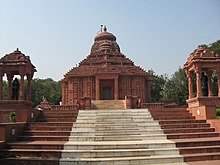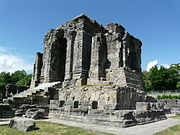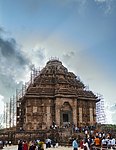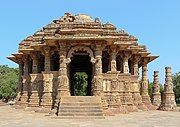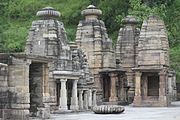Sun temple

A sun temple (or solar temple) is a building used for religious or spiritual activities, such as prayer and sacrifice, dedicated to the sun or a solar deity. Such temples were built by a number different cultures and are distributed around the world including in India,[1] China, Egypt, Japan and Peru. Some of the temples are in ruins, undergoing excavation, preservation or restoration and a few are listed as World Heritage Sites individually or as part of a larger site, such as Konark.[2]
China[]

The Temple of the Sun in Beijing, China, was built in 1530 during the Ming dynasty by the Jiajing Emperor,[3] together with new temples dedicated to the Earth and the Moon, and an expansion of the Temple of Heaven.[3][4] The Temple of the Sun was used by the imperial court for elaborate acts of worship involving fasting, prayers, dancing and animal sacrifices, as part of a year-long cycle of ceremonies involving all the temples.[5] An important element was the colour red, which was associated with the Sun, including red utensils for food and wine offerings, and red clothes for the emperor to wear during the ceremonies.[5] The temple is now part of a public park.[6]
Egypt[]

In ancient Egypt, there were a number of sun temples. Among these old monuments is the Great Temple of Ramses at Abu Simbel,[7] and complexes built by the Fifth Dynasty, of which only two examples survive, that of Userkaf and of Niuserre.[8] The Fifth Dynasty temples usually had three components, a main temple building at a higher elevation, accessed by a causeway, from a much smaller entrance building.[9] In 2006, archaeologists found ruins underneath a market in Cairo, which could possibly be the largest temple built by Ramesses II.[10][11]
Indian subcontinent[]
| |||||
The sun temples of the Indian subcontinent were dedicated to the Hindu deity Surya,[12] with the most prominent among them being the Konark Sun Temple (also known as the Black Pagoda) [13][14] at Konark in Odisha and the Sun Temple at Modhera, Gujarat, built in 1026–1027. Both are now ruins, having been destroyed by invading armies. Konark was constructed around 1250, by Narasimhadeva I of the Eastern Ganga Dynasty,[15][16] and was built in the shape of a large chariot with carved stone wheels, pillars and walls. Surya was an important deity in early Hinduism, but largely ceased to be worshiped as a principal deity around the 12th century. In Manipuri mythology, the sun god Korouhanba is the synonym of the Hindu deity Surya. Other Surya or sun temples in the Indian subcontinent include:
See the detailed list of List of Sun temples in Indian-origin religions.
Inca empire[]

The following are Pre-Columbian temples of Inti (the Inca god Sun):
- Qurikancha in Cusco, Peru, was the most important temple in the Inca Empire.[17]
- Muyuq Marka in Cusco, Peru.
- Willkawaman in Vilcashuamán, Peru.
Others[]
There are also sun temple sites in a number of other countries:
- The Temple of the Sun in the Temple of the Cross Complex, at the Mayan site of Palenque, in southern Mexico, built sometime between 200 and 900 AD.[18][19]
- The Temple of the Night Sun at the Mayan site of El Zotz, Guatemala, possibly abandoned in the fifth century.[20]
- There are several Shinto shrines in Japan, dedicated to the sun goddess Amaterasu including:
- Ise Grand Shrine in Ise, Mie prefecture[21][22]
- Amanawa Shinmei Shrine, founded in 710, in Kamakura
- Amanoiwato-jinja in Takachiho, Miyazaki prefecture[23]
- In the Mesa Verde National Park in Colorado, United States, there is a structure which may have been used as a sun temple by the Pueblo culture,[24] with construction thought to have begun in 1275 AD,[25] although it does not seem to have been completed.[26]
See also[]
- Fire temple
- Temple of the Moon (disambiguation)
- Temple of the Stars
References[]
- ^ "A visit to the Sun Temple". The Hindu. 28 February 2009. Archived from the original on 9 January 2014. Retrieved 9 January 2014.
- ^ "Sun Temple, Konârak". UNESCO. Retrieved 9 January 2014.
- ^ a b "Temple of Heaven: an Imperial Sacrificial Altar in Beijing". World Heritage List. UNESCO. Retrieved 13 January 2014.
- ^ Yanxin Cai (2011). Chinese Architecture. Cambridge University Press. p. 44.
- ^ a b "Traditional life in China: Ruling". Victoria and Albert Museum. Archived from the original on 13 January 2014. Retrieved 13 January 2014.
- ^ "A man walks across a frozen pond at Ritan Park". Times of India. 27 January 2012. Retrieved 13 January 2014.
- ^ "Pharaonic monuments in Aswan". State Information Service, Egypt. Retrieved 9 January 2014.
- ^ Ronald J. Leprohon, ed. (2005). Texts from the Pyramid Age. Society of Biblical Literature. p. 86. ISBN 9004130489.
- ^ Kathryn A. Bard, ed. (1999). Encyclopedia of the Archaeology of Ancient Egypt. Routledge. p. 86. ISBN 9780203982839.
- ^ Stefan Lovgren (1 March 2006). "Giant Ancient Egyptian Sun Temple Discovered in Cairo". National Geographic News. Retrieved 11 January 2014.
- ^ "Ancient sun temple uncovered in Cairo". NBC News. 28 February 2006. Retrieved 11 January 2014.
- ^ A. Bhatnagar; William Livingston; W. C. Livingston (2005). Fundamentals of Solar Astronomy. World Scientific Publishing. p. 28. ISBN 9789812567871.
- ^ Robert Ebersole (1957). Black Pagoda. University of Florida Press. p. 7. Retrieved 13 January 2014.
- ^ "Official website". Tourism Department, Government of Odisha. Retrieved 9 January 2014.
- ^ Robert Ebersole (1957). Black Pagoda. University of Florida Press. p. 34. Retrieved 13 January 2014.
- ^ "Fall of Konark". Tourism Department, Government of Odisha. Retrieved 13 January 2014.
- ^ Carolyn Dean (2010). A Culture of Stone: Inka Perspectives on Rock. Duke University Press. p. 42. ISBN 978-0822393177.
- ^ "Non-Western — Temple of the Sun". California State University, Los Angeles. Retrieved 23 January 2014.
- ^ "Temple of the Sun". Unaahil B'aak:The Temples of Palenque. Wesleyan University. Retrieved 23 January 2014.
- ^ Ker Than (20 July 2012). ""Dramatic" New Maya Temple Found, Covered With Giant Faces". National Geographic News. Retrieved 23 January 2014.
- ^ Brian Bocking (2004), The meanings of Shinto (PDF), School of Oriental and African Studies, University of London, p. 267, retrieved 13 January 2014
- ^ "Sengū Renewal of the Ise Shrine in 2013: Tradition and Rituals". School of Oriental and African Studies, University of London. Retrieved 13 January 2014.
- ^ "Amano-iwato Shrine". Japan National Tourism Organization. Retrieved 13 January 2014.
- ^ J. McKim Malville; Claudia Putnam (1993). Prehistoric Astronomy in the Southwest. Johnson Books. p. 91.
- ^ P. Charbonneau; O.R. White & T.J. Bogdan. "Solar Astronomy in the Prehistoric Southwest". High Altitude Observatory, University Corporation for Atmospheric Research. Retrieved 23 January 2014.
- ^ "Sun Temple". U.S. National Park Service. Retrieved 11 January 2014.
- Sun temples
- Temples
